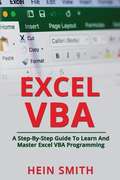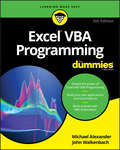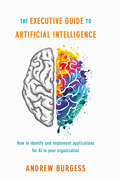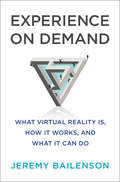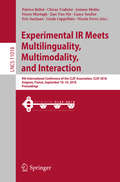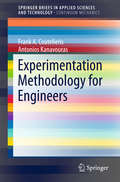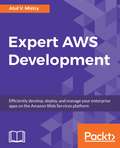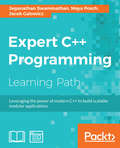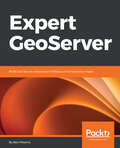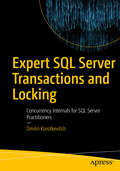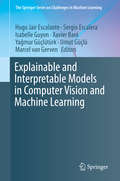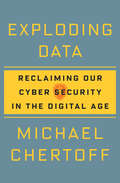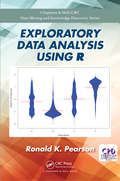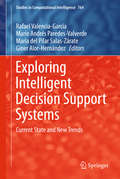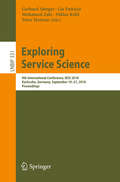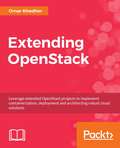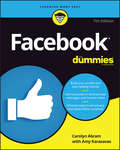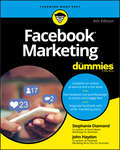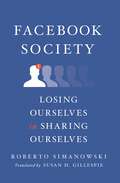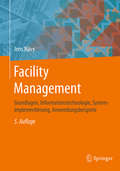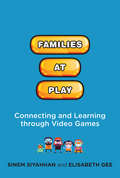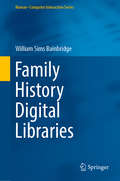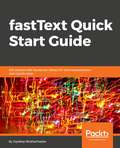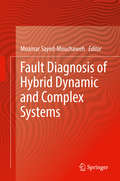- Table View
- List View
Excel VBA: A Step-By-Step Guide to Learn and Master Excel VBA Programming
by Hein SmithWhether you have never created a program with Visual Basic Application or looking to learn some new tricks, then this book is for you! Containing 15 chapters full of information, definitions, and step-by-step instructions to create your own programs, this book will help you master VBA Programming. Here are just a few of the things you will find inside: Chapters on Conditional Logic, String Functions, and Recording Macros Images illustrating the different processes and programming steps Step-by-step instructions for how to program Loops and Arrays 2 chapters on creating and programming User Forms Instructions on how to write Subs and Functions Written out sample codes for many of the programs you will learn how to create How to diagnose and correct your own coding errors A step-by-step process on how to connect the Visual Basic Editor with external dataVisual Basic Application Programming in Excel is a hidden gem that will help you automate and control both basic and complex Excel functions. Following the steps in this book will help you access the inner workings of Excel spreadsheets and take your coding to the next level!
Excel VBA Programming For Dummies
by Michael Alexander John WalkenbachTo take Excel to the next level, you need to understand and implement the power of Visual Basic for Applications (VBA). Excel VBA Programming For Dummies introduces you to a wide array of new Excel options, beginning with the most important tools and operations for the Visual Basic Editor. <p><p> Inside, you’ll find an overview of the essential elements and concepts for programming with Excel. In no time, you’ll discover techniques for handling errors and exterminating bugs, working with range objects and controlling program flow, and much more. With friendly advice on the easiest ways to develop custom dialog boxes, toolbars, and menus, readers will be creating Excel applications custom fit to their unique needs!
The Executive Guide to Artificial Intelligence
by Andrew BurgessThis book takes a pragmatic and hype-free approach to explaining artificial intelligence and how it can be utilised by businesses today. At the core of the book is a framework, developed by the author, which describes in non-technical language the eight core capabilities of Artificial Intelligence (AI). Each of these capabilities, ranging from image recognition, through natural language processing, to prediction, is explained using real-life examples and how they can be applied in a business environment. It will include interviews with executives who have successfully implemented AI as well as CEOs from AI vendors and consultancies. AI is one of the most talked about technologies in business today. It has the ability to deliver step-change benefits to organisations and enables forward-thinking CEOs to rethink their business models or create completely new businesses. But most of the real value of AI is hidden behind marketing hyperbole, confusing terminology, inflated expectations and dire warnings of 'robot overlords'. Any business executive that wants to know how to exploit AI in their business today is left confused and frustrated. As an advisor in Artificial Intelligence, Andrew Burgess regularly comes face-to-face with business executives who are struggling to cut through the hype that surrounds AI. The knowledge and experience he has gained in advising them, as well as working as a strategic advisor to AI vendors and consultancies, has provided him with the skills to help business executives understand what AI is and how they can exploit its many benefits. Through the distilled knowledge included in this book business leaders will be able to take full advantage of this most disruptive of technologies and create substantial competitive advantage for their companies.
Experience on Demand: What Virtual Reality Is, How It Works, and What It Can Do
by Jeremy BailensonAn in-depth look at virtual reality and how it can be harnessed to improve our everyday lives. Virtual reality is able to effectively blur the line between reality and illusion, pushing the limits of our imagination and granting us access to any experience imaginable. With well-crafted simulations, these experiences, which are so immersive that the brain believes they’re real, are already widely available with a VR headset and will only become more accessible and commonplace. But how does this new medium affect its users, and does it have a future beyond fantasy and escapism? In Experience on Demand, Jeremy Bailenson draws on two decades spent researching the psychological effects of VR and other mass media to help readers understand this powerful new tool. He offers expert guidelines for interacting with VR and describes the profound ways this technology can be put to use—not to distance ourselves from reality, but to enrich our lives and influence us to treat others, the environment, and even ourselves better. In the world of VR, a football quarterback plays a game against a competing team hundreds of times before even stepping onto the field; members of the United Nations embody a young girl in a refugee camp going through her day-to-day life; and veterans once again walk through the streets where they had experienced trauma. There are dangers and many unknowns in using VR, but it also can help us hone our performance, recover from trauma, improve our learning and communication abilities, and enhance our empathic and imaginative capacities. Like any new technology, its most incredible uses might be waiting just around the corner. Experience on Demand is the definitive look at the risks and potential of VR—a must-read for navigating both the virtual and the physical worlds ahead.
Experimental IR Meets Multilinguality, Multimodality, and Interaction: 9th International Conference of the CLEF Association, CLEF 2018, Avignon, France, September 10-14, 2018, Proceedings (Lecture Notes in Computer Science #11018)
by Patrice Bellot Chiraz Trabelsi Josiane Mothe Fionn Murtagh Jian Yun Nie Laure Soulier Eric SanJuan Linda Cappellato Nicola FerroThis book constitutes the refereed proceedings of the 9th International Conference of the CLEF Initiative, CLEF 2018, jointly organized by Avignon, Marseille and Toulon universities and held in Avignon, France, in September 2018. The conference has a clear focus on experimental information retrieval with special attention to the challenges of multimodality, multilinguality, and interactive search ranging from unstructured to semi structures and structured data. The 13 papers presented in this volume were carefully reviewed and selected from 39 submissions. Many papers tackle the medical ehealth and ehealth multimedia retrieval challenges, however there are many other topics of research such as document clustering, social biases in IR, social book search, personality profiling. Further this volume presents 9 “best of the labs” papers which were reviewed as a full paper submission with the same review criteria. The labs represented scientific challenges based on new data sets and real world problems in multimodal and multilingual information access. In addition to this, 10 benchmarking labs reported results of their yearlong activities in overview talks and lab sessions. The papers address all aspects of information access in any modularity and language and cover a broad range of topics in the field of multilingual and multimodal information access evaluation.
Experimentation Methodology for Engineers (SpringerBriefs in Applied Sciences and Technology)
by Frank A. Coutelieris Antonios KanavourasThis book delivers a methodological approach on the experimentation and/or simulation processes from the disclaiming hypothesis on a physical phenomenon to the validation of the results. The main benefit of the book is that it discusses all the topics related to experimentation and validation of the outcome including state-of-the-art applications and presents important theoretical, mathematical and experimental developments, providing a self-contained major reference that is appealing to both the scientists and the engineers. At the same time, these topics are encountered in a variety of scientific and engineering disciplines. As a first step, it presents the theoretical and practical implications on the formation of a hypothesis, considering the existing knowledge collection, classification and validation of the particular areas of experimenting interest. Afterwards, the transition from the knowledge classes to the experimentation parameters according to the phenomena evolution contributors and the systemic properties of the descriptors are discussed. The major experimenting requirements focus on the conditions to satisfy a potential disclaim of the initial hypothesis as conditions. Furthermore, the experimentation outcome, as derived via the previous experimentation process set-up, would be validate for the similarities among the existing knowledge and derived new one. The whole methodology offers a powerful tool towards the minimization of research effort wastes, as far as it can identify the lacks of knowledge, thus the areas of interest where the current research has to work on. The special features of this book are (a) the use of state-of-the-art techniques for the classification of knowledge, (b) the consideration of a realistic systemic world of engineering approached phenomena, (c) the application of advanced mathematical techniques for identifying, describing and testing the similarities in the research results and conclusions, and (d) the experimental investigation of relevant phenomena.
Expert AWS Development: Efficiently develop, deploy, and manage your enterprise apps on the Amazon Web Services platform
by Atul MistryKey concepts, sample applications, best practices, and troubleshooting tips to build highly scalable applications in AWS. Key FeaturesDesign highly available, cost efficient, fault tolerant, and scalable distributed systemsA practical guide that will help you build, deploy, and manage applications with ease.Develop effective solutions with AWS SDK and LambdaBook DescriptionContinuous deployment and Agile methodology have enabled huge advances in modern applications. This book will enable the reader to make use of this rapidly evolving technology to build highly scalable applications within AWS using different architectures.You will begin with installation of AWS SDK and you will get hands-on experience on creating an application using AWS Management Console and AWS Command Line Interface (CLI). Next you will be integrating Applications with AWS services such as DynamoDB, Amazon Kinesis, AWS Lambda, Amazon SQS and Amazon SWFFollowing this you will get well versed with CI/CD workflow and work with four major phases in Release processes – Source, Build, Test and Production. Next you will learn to apply AWS developer tools in your Continuous Integration (CI) and Continuous Deployment (CD) WorkFlow. Later you will learn about User Authentication using Amazon Cognito and also how you can evaluate the best architecture as per your infrastructure costs. You will learn about Amazon EC2 service and deploy an app using Amazon EC2.You will also get well versed with container service which is Amazon EC2 Container Service (Amazon ECS) and you will learn to deploy an app using Amazon ECS. Along with EC2 and ECS, you will also deploying a practical real-world example of a CI/CD application with the Serverless Application Framework which is known as AWS Lambda. Finally you will learn how to build, develop and deploy the Application using AWS Developer tools like AWS CodeCommit, AWS CodeBuild, AWS CodeDeploy and AWS CodePipeline as per project needs. Also you can develop and deploy applications within minutes using AWS CodeStar from wizard.By the end of this book, the reader will effectively build, deploy, and manage applications on AWS along with scaling and securing applications with best practices and troubleshooting tips.What you will learnLearn how to get up and running with AWS Developer Tools.Integrate the four major phases in the Release Processes. Source, Build, Test and Production.Learn how to integrate Continuous Integration, Continuous Delivery, and Continuous Deployment in AWS.Make secure, scalable and fault tolerant applications.Understand different architectures and deploy complex architectures within minutesWho this book is forThis book targets developers who would like to build and manage web and mobile applications and services on the AWS platform. If you are an architect you will be able to take a deep dive and use examples that can be readily applied to real world scenarios. Some prior programming experience is assumed along with familiarity of cloud computing.
Expert C++ Programming: Leveraging the power of modern C++ to build scalable modular applications
by Maya Posch Jacek GalowiczDeveloping expert level application development skills with C++Key Features- Take advantage of the myriad of features and possibilities that C++ offers to build real-world applications- Delve into the fundamentals of multithreading and concurrency and find out how to implement them- Learn the latest features of C++ and how to write better code by using the Standard Library Book DescriptionC++ has come a long way and has now been adopted in several contexts. Its key strengths are its software infrastructure and resource-constrained applications. The C++ 17 release will change the way developers write code, and this course will help you master your developing skills with C++. With real-world, practical examples explaining each concept, the course is divided into three modules where will begin by introducing you to the latest features in C++ 17. It encourages clean code practices in C++ in general and demonstrates the GUI app-development options in C++. You’ll get tips on avoiding memory leaks using smart-pointers. In the next module, you’ll see how multi-threaded programming can help you achieve concurrency in your applications. We start with a brief introduction to the fundamentals of multithreading and concurrency concepts. We then take an in-depth look at how these concepts work at the hardware-level as well as how both operating systems and frameworks use these low-level functions. You will learn about the native multithreading and concurrency support available in C++ since the 2011 revision, synchronization and communication between threads, debugging concurrent C++ applications, and the best programming practices in C++.Moving on, you’ll get an in-depth understanding of the C++ Standard Template Library. Where we show implementation-specific, problem-solution approach that will help you quickly overcome hurdles. You will learn the core STL concepts, such as containers, algorithms, utility classes, lambda expressions, iterators, and more while working on practical real-world recipes. These recipes will help you get the most from the STL and show you how to program in a better way.Jeganathan Swaminathan : Mastering C++ ProgrammingMaya Posch : Mastering C++ MultithreadingJacek Galowicz : C++17 STL CookbookWhat you will learn Write modular C++ applications in terms of the existing and newly introduced features Identify code-smells, clean up, and refactor legacy C++ applications Leverage the possibilities provided by Cucumber and Google Test/Mock to automate test casesDeep dive into the details of the how various operating systems currently implement multithreading Choose the best multithreading APIs when designing a new application Explore the use of mutexes, spin-locks, and other synchronization concepts and see how to safely pass data between threads Work with strings the STL way instead of handcrafting C-style code Understand standard support classes for concurrency and synchronization, and how to put them to work Use the filesystem library addition available with the C++17 STLWho this book is forThis course is for intermediate to advanced level C++ developers who want to get the most out of C++ to build concurrent and scalable application.
Expert GeoServer: Build and secure advanced interfaces and interactive maps
by Ben MearnsA fast-paced guide to putting your GeoServer-based application into fast, user-friendly, and secure productionKey Features Resolve bottlenecks, optimize data stores, and cluster server resources Use identity management and authentication for a user-specific, secure web application Go beyond traditional web hosting to explore the full range of hosting options in the cloudBook DescriptionGeoServer is open source, server-side software written in Java that allows users to share and edit geospatial data. In this book, you'll start by learning how to develop a spatial analysis platform with web processing services. Then you'll see how to develop an algorithm by chaining together geospatial analysis processes, which you can share with anyone in the world. Next you'll delve into a very important technique to improve the speed of your map application—tile caching. Here, you'll understand how tile caching works, how to develop an effective tile cache-supported web service, and how to leverage tile caching in your OpenLayers web application.Further on, you'll explore important tweaks to produce a performant GeoServer-backed web mapping application. Moving on, you'll enable authentication on the frontend and backend to protect sensitive map data, and deliver sensitive data to your end user. Finally, you'll see how to put your web application into production in a secure and user-friendly way. You'll go beyond traditional web hosting to explore the full range of hosting options in the cloud, and maintain a reliable server instance.What you will learn Develop a WPS-processing service to allow web-based geospatial data processing Get to know important techniques to improve the speed of your web map application—tile caching, raster data optimization, and server clustering Find out which GeoServer settings resolve bottlenecks Develop an algorithm by chaining geospatial analysis processes together Put your application into production with hosting, monitoring, and automated backup and recovery Understand how to develop an effective tile cache-supported web service Master techniques that ensure resilient server deploymentWho this book is forThis book is for anyone who wants to learn about advanced interfaces, security, and troubleshooting techniques in GeoServer. A basic understanding of GeoServer is required
Expert SQL Server Transactions and Locking: Concurrency Internals for SQL Server Practitioners
by Dmitri KorotkevitchMaster SQL Server’s Concurrency Model so you can implement high-throughput systems that deliver transactional consistency to your application customers. This book explains how to troubleshoot and address blocking problems and deadlocks, and write code and design database schemas to minimize concurrency issues in the systems you develop.SQL Server’s Concurrency Model is one of the least understood parts of the SQL Server Database Engine. Almost every SQL Server system experiences hard-to-explain concurrency and blocking issues, and it can be extremely confusing to solve those issues without a base of knowledge in the internals of the Engine. While confusing from the outside, the SQL Server Concurrency Model is based on several well-defined principles that are covered in this book.Understanding the internals surrounding SQL Server’s Concurrency Model helps you build high-throughput systems in multi-user environments. This book guides you through the Concurrency Model and elaborates how SQL Server supports transactional consistency in the databases. The book covers all versions of SQL Server, including Microsoft Azure SQL Database, and it includes coverage of new technologies such as In-Memory OLTP and Columnstore Indexes.What You'll LearnKnow how transaction isolation levels affect locking behavior and concurrencyTroubleshoot and address blocking issues and deadlocksProvide required data consistency while minimizing concurrency issuesDesign efficient transaction strategies that lead to scalable codeReduce concurrency problems through good schema designUnderstand concurrency models for In-Memory OLTP and Columnstore IndexesReduce blocking during index maintenance, batch data load, and similar tasksWho This Book Is ForSQL Server developers, database administrators, and application architects who are developing highly-concurrent applications. The book is for anyone interested in the technical aspects of creating and troubleshooting high-throughput systems that respond swiftly to user requests.
Explainable and Interpretable Models in Computer Vision and Machine Learning (The Springer Series on Challenges in Machine Learning)
by Hugo Jair Escalante Sergio Escalera Isabelle Guyon Xavier Baró Yağmur Güçlütürk Umut Güçlü Marcel Van GervenThis book compiles leading research on the development of explainable and interpretable machine learning methods in the context of computer vision and machine learning. Research progress in computer vision and pattern recognition has led to a variety of modeling techniques with almost human-like performance. Although these models have obtained astounding results, they are limited in their explainability and interpretability: what is the rationale behind the decision made? what in the model structure explains its functioning? Hence, while good performance is a critical required characteristic for learning machines, explainability and interpretability capabilities are needed to take learning machines to the next step to include them in decision support systems involving human supervision. This book, written by leading international researchers, addresses key topics of explainability and interpretability, including the following: · Evaluation and Generalization in Interpretable Machine Learning · Explanation Methods in Deep Learning · Learning Functional Causal Models with Generative Neural Networks · Learning Interpreatable Rules for Multi-Label Classification · Structuring Neural Networks for More Explainable Predictions · Generating Post Hoc Rationales of Deep Visual Classification Decisions · Ensembling Visual Explanations · Explainable Deep Driving by Visualizing Causal Attention · Interdisciplinary Perspective on Algorithmic Job Candidate Search · Multimodal Personality Trait Analysis for Explainable Modeling of Job Interview Decisions · Inherent Explainability Pattern Theory-based Video Event Interpretations
Exploding Data: Reclaiming Our Cyber Security in the Digital Age
by Michael ChertoffA former Secretary of Homeland Security examines our outdated laws regarding the protection of personal information, and the pressing need for change. Nothing undermines our freedom more than losing control of information about ourselves. And yet, as daily events underscore, we are ever more vulnerable to cyber-attack. In this bracing book, Michael Chertoff makes clear that our laws and policies surrounding the protection of personal information, written for an earlier time, are long overdue for a complete overhaul. On the one hand, the collection of data—more widespread by business than by government, and impossible to stop—should be facilitated as an ultimate protection for society. On the other, standards under which information can be inspected, analyzed, or used must be significantly tightened. In offering his compelling call for action, Chertoff argues that what is at stake is not so much the simple loss of privacy, which is almost impossible to protect, but of individual autonomy—the ability to make personal choices free of manipulation or coercion. Offering vivid stories over many decades that illuminate the three periods of data gathering we have experienced, Chertoff explains the complex legalities surrounding issues of data collection and dissemination today, and charts a path that balances the needs of government, business, and individuals alike. &“Surveys the brave new world of data collection and analysis…The world of data as illuminated here would have scared George Orwell.&”―Kirkus Reviews &“Chertoff has a unique perspective on data security and its implications for citizen rights as he looks at the history of and changes in privacy laws since the founding of the U.S.&”—Booklist
Exploratory Data Analysis Using R (Chapman and Hall/CRC Data Mining and Knowledge Discovery Series)
by Ronald K. PearsonExploratory Data Analysis Using R provides a classroom-tested introduction to exploratory data analysis (EDA) and introduces the range of "interesting" – good, bad, and ugly – features that can be found in data, and why it is important to find them. It also introduces the mechanics of using R to explore and explain data. The book begins with a detailed overview of data, exploratory analysis, and R, as well as graphics in R. It then explores working with external data, linear regression models, and crafting data stories. The second part of the book focuses on developing R programs, including good programming practices and examples, working with text data, and general predictive models. The book ends with a chapter on "keeping it all together" that includes managing the R installation, managing files, documenting, and an introduction to reproducible computing. The book is designed for both advanced undergraduate, entry-level graduate students, and working professionals with little to no prior exposure to data analysis, modeling, statistics, or programming. it keeps the treatment relatively non-mathematical, even though data analysis is an inherently mathematical subject. Exercises are included at the end of most chapters, and an instructor's solution manual is available.
Exploring Intelligent Decision Support Systems: Current State and New Trends (Studies in Computational Intelligence #764)
by Giner Alor-Hernández María del Pilar Salas-Zárate Mario Andrés Paredes-Valverde Rafael Valencia-GarcíaThis book presents innovative and high-quality research regarding advanced decision support systems (DSSs). It describes the foundations, methods, methodologies, models, tools, and techniques for designing, developing, implementing and evaluating advanced DSSs in different fields, including finance, health, emergency management, industry and pollution control. Decision support systems employ artificial intelligence methods to heuristically address problems that are cannot be solved using formal techniques. In this context, technologies such as the Semantic Web, linked data, big data, and machine learning are being applied to provide integrated support for individuals and organizations to make more rational decisions. The book is organized into two parts. The first part covers decision support systems for industry, while the second part presents case studies related to clinical emergency management and pollution control.
Exploring Service Science: 9th International Conference, IESS 2018, Karlsruhe, Germany, September 19–21, 2018, Proceedings (Lecture Notes in Business Information Processing #331)
by Gerhard Satzger Lia Patrício Mohamed Zaki Niklas Kühl Peter HottumThis book constitutes the proceedings of the 9th International Conference on Exploring Services Science, IESS 2018, held in Karlsruhe, Germany, in September 2018. The 30 papers presented in this volume were carefully reviewed and selected from 67 submissions. The book is structured in six parts, each featuring contributions describing current research in a particular domain of service science: Service Design and Innovation; Smart Service Processes; Big Data in Services; Service Topics Open Exploration; Design Science Research in Services. The book offers an extended, ICT-focused vision on services and addresses multiple relevant aspects, including underlying business models, the necessary processes and technological capabilities like big data and machine learning. The academic work showcased at the conference should help to advance service science and its application in practice.
Extending OpenStack: Leverage extended OpenStack projects to implement containerization, deployment, and architecting robust cloud solutions
by Omar KhedherDiscover new opportunities to empower your private cloud by making the most of the OpenStack universe Key Features This practical guide teaches you how to extend the core functionalities of OpenStack Discover OpenStack's flexibility by writing custom applications and network plugins Deploy a containerized environment in OpenStack through a hands-on and example-driven approach Book Description OpenStack is a very popular cloud computing platform that has enabled several organizations during the last few years to successfully implement their Infrastructure as a Service (IaaS) platforms. This book will guide you through new features of the latest OpenStack releases and how to bring them into production straightaway in an agile way. It starts by showing you how to expand your current OpenStack setup and how to approach your next OpenStack Data Center generation deployment. You will discover how to extend your storage and network capacity and also take advantage of containerization technology such as Docker and Kubernetes in OpenStack. Additionally, you'll explore the power of big data as a Service terminology implemented in OpenStack by integrating the Sahara project. This book will teach you how to build Hadoop clusters and launch jobs in a very simple way. Then you'll automate and deploy applications on top of OpenStack. You will discover how to write your own plugin in the Murano project. The final part of the book will go through best practices for security such as identity, access management, and authentication exposed by Keystone in OpenStack. By the end of this book, you will be ready to extend and customize your private cloud based on your requirements. What you will learn Explore new incubated projects in the OpenStack ecosystem and see how they work Architect your OpenStack private cloud with extended features of the latest versions Consolidate OpenStack authentication in your large infrastructure to avoid complexity Find out how to expand your computing power in OpenStack on a large scale Reduce your OpenStack storage cost management by taking advantage of external tools Provide easy, on-demand, cloud-ready applications to developers using OpenStack in no time Enter the big data world and find out how to launch elastic jobs easily in OpenStack Boost your extended OpenStack private cloud performance through real-world scenarios Who this book is for This book is for system administrators, cloud architects, and developers who have experience working with OpenStack and are ready to step up and extend its functionalities. A good knowledge of basic OpenStack components is required. In addition, familiarity with Linux boxes and a good understanding of network and virtualization jargon is required.
Facebook For Dummies
by Carolyn Abram Amy KarasavasTake control of your Facebook profile When you join Facebook, you're joining a community with over two billion people spread around the globe. It helps to have the insight on not only how to set up your profile and add content, but also how to make sure you control who sees—and doesn't see—your posts. Facebook For Dummies provides the trusted guidance you need to set up a profile, add content, and apply the many tools Facebook provides to give you control of your content. Primarily known as a way for individuals to share information, photos and videos, and calendar invitations, Facebook has gained prominence as a means to spread news, market products, and serve as a business platform. Whatever you’re looking to use it for, this book shows you how to use all the features available to make it a more satisfying experience. Build your profile and start adding friends Use Facebook to send private messages and instant notes Discover ways to set privacy and avoid online nuisances Launch a promotion page Get ready to have a whole lot of fun on the largest social network in the world.
Facebook Marketing For Dummies (For Dummies Series)
by Stephanie Diamond John HaydonAdd Facebook to your marketing plan—and watch your sales grow With 2 billion monthly active users across the world, Facebook has evolved into a community of consumers, creating a primary resource for marketers. This presents a demand for knowledge about how to strategically plan, execute, and analyze a successful Facebook marketing campaign. Now, the trusted Facebook Marketing For Dummies has been fully updated to cover the newest tools and features important to marketers and Facebook page owners. If you’re a marketer looking to effectively add Facebook to your overall marketing mix, consider this book the mecca of Facebook marketing. Inside, you'll discover the psychology of the Facebook user, establish a social media presence, increase your brand awareness, integrate Facebook marketing with other marketing strategies, learn to target a specific audience, and much more. Develop a desirable community Sell products and services Use Facebook events to drive sales Get new business tips and avoid common mistakes Whether you're a novice or a pro, you’re no stranger to the power of Facebook. And this book makes Facebook marketing that much more exciting and easy!
Facebook Society: Losing Ourselves in Sharing Ourselves
by Roberto SimanowskiFacebook claims that it is building a “global community.” Whether this sounds utopian, dystopian, or simply self-promotional, there is no denying that social-media platforms have altered social interaction, political life, and outlooks on the world, even for people who do not regularly use them. In this book, Roberto Simanowski takes Facebook as a starting point to investigate our social-media society—and its insidious consequences for our concept of the self.Simanowski contends that while they are often denounced as outlets for narcissism and self-branding, social networks and the practices they cultivate in fact remake the self in their image. Sharing is the outsourcing of one’s experiences, encouraging unreflective self-narration rather than conscious self-determination. Instead of experiencing the present, we are stuck ceaselessly documenting and archiving it. We let our lives become episodic autobiographies whose real author is the algorithm lurking behind the interface. As we go about accumulating more material for the platform to arrange for us, our sense of self becomes diminished—and Facebook shapes a subject who no longer minds. Social-media companies’ relentless pursuit of personal data for advertising purposes presents users with increasingly targeted, customized information, attenuating cultural memory and fracturing collective identity. Presenting a creative, philosophically informed perspective that speaks candidly to a shared reality, Facebook Society asks us to come to terms with the networked world for our own sake and for all those with whom we share it.
Facebook—Can Ethics Scale in the Digital Age?
by Carin-Isabel Knoop George A. RiedelSince its founding in 2004, Facebook has built a phenomenally successful business at global scale to become the fifth most valuable public company in the world. The revelation of Cambridge Analytica events in March 2018, where 78 million users' information was leaked in a 2016 US election cycle, exposed a breach of trust/privacy amongst its user community. In the past, growth at any costs appeared to be the de facto strategy. Now many voices such as regulators, advertisers, ethicists, shareholders and users argued for a more responsible approach to addressing their concerns. Mark Zuckerberg (CEO/Chair/Founder) and Sheryl Sandberg (COO) mapped out their six-point plan to address this existential threat. Could they continue to grow and rectify the breach of trust/privacy? Did other stakeholders have some greater responsibility too? In addition to issues of privacy and trust, there is a growing chorus of concern about "content moderation" - not for the easy topics like spam or copyright material -but for the hard things around political points of view, hate speech, polarizing perspectives, etc. How will Facebook strike the balance between free speech and corrosive content across billions of users and dozens of languages? Are they the arbiters of truth/censorship in the digital world?
Facility Management: Grundlagen, Informationstechnologie, Systemimplementierung, Anwendungsbeispiele
by Jens NävyIndustrie- und Wohnungsunternehmen verwalten ihre Gebäude, Anlagen und Grundstücke mit Hilfe des Facility Management (FM). Dieses Buch informiert über die Informationstechnologie im FM. Das Computer Aided Facility Management (CAFM) bildet dabei den Schwerpunkt. Gegenüber der 3. Auflage sind die Marktübersicht und Ausführungen dazu aktualisiert. Der Autor betreibt selber beratend die Professionalisierung der Gebäude- und Immobilienbewirtschaftung.
Families at Play: Connecting and Learning through Video Games (The John D. and Catherine T. MacArthur Foundation Series on Digital Media and Learning)
by Sinem Siyahhan Elisabeth GeeHow family video game play promotes intergenerational communication, connection, and learning.Video games have a bad reputation in the mainstream media. They are blamed for encouraging social isolation, promoting violence, and creating tensions between parents and children. In this book, Sinem Siyahhan and Elisabeth Gee offer another view. They show that video games can be a tool for connection, not isolation, creating opportunities for families to communicate and learn together.Like smartphones, Skype, and social media, games help families stay connected. Siyahhan and Gee offer examples: One family treats video game playing as a regular and valued activity, and bonds over Halo. A father tries to pass on his enthusiasm for Star Wars by playing Lego Star Wars with his young son. Families express their feelings and share their experiences and understanding of the world through playing video games like The Sims, Civilization, and Minecraft. Some video games are designed specifically to support family conversations around such real-world issues and sensitive topics as bullying and peer pressure.Siyahhan and Gee draw on a decade of research to look at how learning and teaching take place when families play video games together. With video games, they argue, the parents are not necessarily the teachers and experts; all family members can be both teachers and learners. They suggest video games can help families form, develop, and sustain their learning culture as well as develop skills that are valued in the twenty-first century workplace. Educators and game designers should take note.
Family History Digital Libraries
by William Sims BainbridgeIn the modern era, every family and local community can cultivate its own history, endowing living people with meanings inherited from the people of the past, by means of today’s computer-based information and communication technologies. A new profession is emerging, family historians, serving the wider public by assisting in collection and analysis of fascinating data, by teaching talented amateur historians, and by producing complete narratives. Essential are the skills and technologies required to preserve and connect photos, movies, videos, diaries, memoirs, correspondence, artefacts and even architecture such as homes. Online genealogical services are well established sources of official government records, but usually not for recent decades, and not covering the valuable records of legal, medical, and religious organizations. Information can be shared and interpreted by family members through oral history interviews, social media, and online private archives such as wikis and shared file depositories. This book explores a wide variety of online information sources and achieves coherence by documenting and interpreting the history of a particular extended American family on the basis of 9 decades of movies and videos, 17 decades of photographs, and centuries of documents. Starting now, any family may begin to preserve their current experiences for the historians of the future, but this will require social as well as technical innovations. This book is the essential resource, providing the fundamental principles, effective methods, and fascinating questions required to make our past live again.
fastText Quick Start Guide: Get started with Facebook's library for text representation and classification
by Joydeep BhattacharjeePerform efficient fast text representation and classification with Facebook's fastText libraryKey FeaturesIntroduction to Facebook's fastText library for NLPPerform efficient word representations, sentence classification, vector representationBuild better, more scalable solutions for text representation and classificationBook DescriptionFacebook's fastText library handles text representation and classification, used for Natural Language Processing (NLP). Most organizations have to deal with enormous amounts of text data on a daily basis, and gaining efficient data insights requires powerful NLP tools such as fastText. This book is your ideal introduction to fastText. You will learn how to create fastText models from the command line, without the need for complicated code. You will explore the algorithms that fastText is built on and how to use them for word representation and text classification. Next, you will use fastText in conjunction with other popular libraries and frameworks such as Keras, TensorFlow, and PyTorch. Finally, you will deploy fastText models to mobile devices. By the end of this book, you will have all the required knowledge to use fastText in your own applications at work or in projects.What you will learnCreate models using the default command line options in fastTextUnderstand the algorithms used in fastText to create word vectorsCombine command line text transformation capabilities and the fastText library to implement a training, validation, and prediction pipelineExplore word representation and sentence classification using fastTextUse Gensim and spaCy to load the vectors, transform, lemmatize, and perform other NLP tasks efficientlyDevelop a fastText NLP classifier using popular frameworks, such as Keras, Tensorflow, and PyTorchWho this book is forThis book is for data analysts, data scientists, and machine learning developers who want to perform efficient word representation and sentence classification using Facebook's fastText library. Basic knowledge of Python programming is required.
Fault Diagnosis of Hybrid Dynamic and Complex Systems
by Moamar Sayed-MouchawehOnline fault diagnosis is crucial to ensure safe operation of complex dynamic systems in spite of faults affecting the system behaviors. Consequences of the occurrence of faults can be severe and result in human casualties, environmentally harmful emissions, high repair costs, and economical losses caused by unexpected stops in production lines. The majority of real systems are hybrid dynamic systems (HDS). In HDS, the dynamical behaviors evolve continuously with time according to the discrete mode (configuration) in which the system is. Consequently, fault diagnosis approaches must take into account both discrete and continuous dynamics as well as the interactions between them in order to perform correct fault diagnosis. This book presents recent and advanced approaches and techniques that address the complex problem of fault diagnosis of hybrid dynamic and complex systems using different model-based and data-driven approaches in different application domains (inductor motors, chemical process formed by tanks, reactors and valves, ignition engine, sewer networks, mobile robots, planetary rover prototype etc.). These approaches cover the different aspects of performing single/multiple online/offline parametric/discrete abrupt/tear and wear fault diagnosis in incremental/non-incremental manner, using different modeling tools (hybrid automata, hybrid Petri nets, hybrid bond graphs, extended Kalman filter etc.) for different classes of hybrid dynamic and complex systems.
